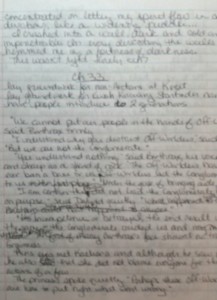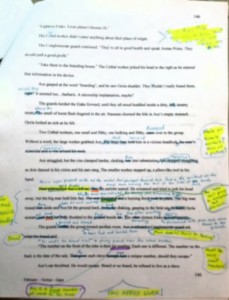 My massive revision of Veritas (a YA sci-fi) is moving apace. Some chapters fight me hard—I have so much to revise and add that I virtually (and sometimes literally) rewrite them. But some chapters I tweak. Perhaps add a sentence or a few phrase. Those chapters provide a break for me, but when I get several “tweak” chapters in a row, I start second-guessing myself.
My massive revision of Veritas (a YA sci-fi) is moving apace. Some chapters fight me hard—I have so much to revise and add that I virtually (and sometimes literally) rewrite them. But some chapters I tweak. Perhaps add a sentence or a few phrase. Those chapters provide a break for me, but when I get several “tweak” chapters in a row, I start second-guessing myself.
After struggling with a chapter that knocks me down, talks back to me, and generally kicks me around, when I get a tweak chapter I feel like I must be missing something. I mean, it can’t be that easy. Not when the last chapter was so hard. There must be some glaring mistake I am not seeing.
So I scrutinize and I poke and I prod, but I end up back where I started. I think this chapter is all right. But am I right? Second-guessing.
 Luckily, this is where critique partners come in. They will look at my chapters, the fighters and the tweaks, and tell me if I’ve missed something. If weaknesses hide beneath the polished surface. They will tell me what doesn’t ring true, what doesn’t feel real, and what knocks them out of the story. Hopefully, this revision will have fixed most of those things.
Luckily, this is where critique partners come in. They will look at my chapters, the fighters and the tweaks, and tell me if I’ve missed something. If weaknesses hide beneath the polished surface. They will tell me what doesn’t ring true, what doesn’t feel real, and what knocks them out of the story. Hopefully, this revision will have fixed most of those things.
Once I get their feedback, I will no longer second guess myself. Until then, I will continue to plod through the revision. I’ve just finished chapter 36…of 83. So there is plenty of second-guessing ahead for me!
What about you? Do you find yourself wondering what you’ve missed when revisions seem “too easy”?


Research, Balance, and Fish
We’ve had a total of 5 fish, but are down to 3. We lost one (quite literally lost him) the first night, while the second leaped from the tank about a week later and never recovered. How they got out of the tank through a skinny opening in the dead of night we don’t know. But we have fixed this issue with a new cover. A little research may have saved their lives, but who knows?
RIP Seashell 1
RIP Sparkleshine
What more research WOULD have prepared us for is the difficulty of maintaining the proper chemical balance in our tank. We let the water sit and percolate for a week before adding the first 2 fish. Turns out we should have let it “cycle” for at least a month, maybe more, before adding the fish. Now we are trying to control the ammonia and nitrite cycle while fish are in the tank, which is very stressful, because a spike in either ammonia or nitrite can kill the fish in a mass extinction event (we very nearly had one a week ago).
So here we are with fish and struggling to keep them alive through this natural aquarium cycling process, when a little more research would have saved us the headache. And the same can happen when writing. A little research in the beginning can keep your manuscript from going off the rails.
Seashell 2
Some people do extensive research before writing. Some research as they go along. I am in the middle. I do broad-stroke research before I write, and fill in the details as I need them. But by doing basic research first, I know the broad restrictions I need to work within. This saves me from writing the whole book, then finding out I had a fundamental flaw which now requires me to rewrite an entire plotline. So a little research can save a lot of angst later on.
The other thing about the aquarium is that the ammonia and nitrite need to be kept at 0 ppm, or you end up with stressed and perhaps dead fish. Bacteria are supposed to eat the ammonia and the nitrite, keeping the whole thing in balance. But little things can throw the cycle off and suddenly your water is testing in the danger zone.
Gem
The writing life is like that, too—a delicate balance. Writers juggle writing and daily life, often including family and a day job. It’s not easy to keep the water balanced right. One little thing can send one part of your life spiraling into the danger zone. All we can do is keep testing the water and try to head off any problems we see. One way to do that in an aquarium is partial water changes. We can do that in life, too. If one issue is causing undue stress, can we change it up, change it out? Sometimes a small change can make a huge difference.
Research will save you headaches. Balance will save you heartaches. And fish…well, fish are cool when they’re not jumping out of the tank in the dead of night.
When do you research your manuscript? How do you maintain a healthy balance in your life?
Flower
Save
Save
Save
Save